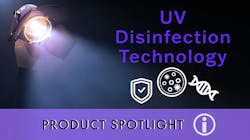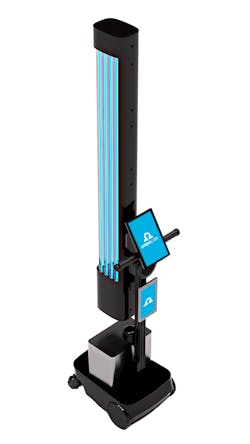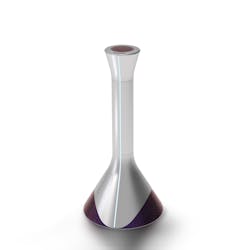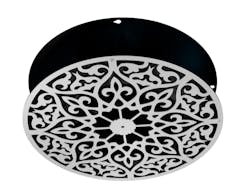LEDs Magazine continues to survey ultraviolet- (UV-)emitting offerings in the marketplace that are shaping applications for air and surface disinfection as well as water purification. Along with LED-based products and applications, we include state-of-the-art technologies integrating other UV sources because they will continue to inform LED performance improvements, cost and efficacy requirements, evolving industry standards, and test/measurement best practices.
COMPILED BY CARRIE MEADOWS
GLO, UV Resources
The GLO (Germicidal Light Overhead) open-style UV-C fixture delivers upper-room disinfection for high-ceiling areas via two models: GLO 900-OF (25W lamp/372 mW radiant power) to treat up to 900 ft2 and GLO 1500-OF (36W lamp/625 mW radiant power) for up to 1500 ft2. An aluminum parabolic reflector reduces internal UV energy losses, optimizing the UV germicidal irradiation (UVGI) for 24/7 disinfection of airborne bacteria, viruses, and mold spores. An adjustable guide protects occupants from UV exposure.
PearlAqua Tera, AquiSense Technologies
The fully enclosed, LED-based PearlAqua Tera system disinfects municipal and industrial water supplies with flow rates up to 2 MGD (millions of gallons per day). Custom designs accommodate various flange sizes and may be equipped with one to three UV-C LED lamp arrays in a replaceable module. PearlAqua Tera provides online UV intensity monitoring, instant on/off, and variable power delivery according to demand. CE- and RoHS-certified systems are manufactured in an ISO 9001:2015 facility in the U.S.
OhmniClean, OhmniLabs
The 58-lb OhmniClean robot disinfects up to 3000-ft2 areas in 15 minutes using 254-nm low-pressure mercury lamps. Cloud-based mapping software assesses the room layout and enables autonomous disinfection while the space is unoccupied. Safety features include timed setup before initiating a clean cycle, motion sensors, remote switches, and warning displays during operation. The software generates a disinfection report when it completes each cycle and powers off. Swappable batteries, modular parts, and multiple service/lease options support cost and fleet management.
nUVo Tower and Traveler, Energy Focus
UV-C air disinfection goes portable with nUVo Traveler and sanitizes air in small spaces with nUVo Tower (shown). Both Traveler and Tower have been independently validated via Intertek Microbiological Tests to reduce between 94.1% and 99.9% of airborne molds, bacteria, and viruses within 30 minutes in spaces up to 100 ft3 and 1,000 ft3, respectively. The 254-nm–emitting quartz lamp design eliminates costly filter replacements and does not release any chemical fumes or odors. The lamp is specified for 10,000 hours of use (about 3 years at 8 hours runtime per day).
Nautilus and Muwaiji, Air~Lume by Trinity Lighting
Both Nautilus and Muwaiji (shown) utilize 265-nm UV-C LEDs and fan-induced airflow for upper-room germicidal applications. Nautilus consumes approximately 3.2W and Muwaiji 2.4W for energy-efficient operation. LEDs are hidden to prevent UV exposure. Fluence exceeds 10 µW/cm2 at 3m for both models. For comparison, tests by Innovative Labs on a 25W mercury-lamp–based disinfection system demonstrated inactivation of aerosolized coronavirus with a fluence rate of 4 µW/cm2 in a 3m2 chamber.
Kepri, Excelitas Technologies
Kepri upper-air disinfection units employ three sensor types to monitor for active and occupied spaces. Tilt sensors monitor the direction of UV-C emission and instantly stop UV system operation if the emission field settles below 0° threshold of level horizon. Motion and presence sensors detect people entering or remaining in the emission field and shut off the unit until the emission field has remained clear for 15 minutes. Selective operating modes include always on, only on during occupancy, or only on during vacancy.
CARRIE MEADOWS is managing editor of LEDs Magazine, with 20+ years’ experience in business-to-business publishing across technology markets including solid-state technology manufacturing, fiberoptic communications, machine vision, lasers and photonics, and LEDs and lighting.
For up-to-the-minute LED and SSL updates, why not follow us on Twitter? You’ll find curated content and commentary, as well as information on industry events, webcasts, and surveys on our LinkedIn Company Page and Facebook page.












